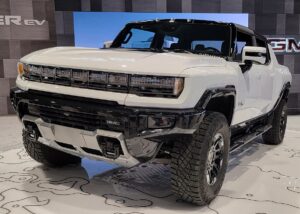The Army has awarded deals to GM Defense [GM] and advanced mobility startup Canoo [GOEV] to each provide an electric vehicle for demonstration, with the goal of informing the service’s planned Electric Light Reconnaissance Vehicle (eLRV) program.
Testing is set to begin this fall as the Army assesses the potential for current electrically-powered commercial platforms to meet military operational requirements, with GM Defense providing the GMC Hummer EV for the effort. Canoo did not specify which of its vehicles it will be providing.

“For this effort, having a range of commercial weight classes, battery storage sizes, and electric drive power helps frame the capabilities of industry. This effort is more targeted at understanding current commercial offerings and their commercial performance against a military duty cycle and profile,” Steve Herrick, product director for ground mobility vehicles in the Army’s Program Executive Office-Combat Support & Combat Service Support, told Defense Daily.
Herrick said the testing will include looking at the battery electric vehicles’ “range, recharge time, distance over various military mission profiles (terrain), pseudo-silent watch understanding, battery management, exportable power” and other areas that could help inform the eLRV’s eventual Abbreviated Capabilities Development Document.
The Army has previously described eLRV as the “first and most promising of developmental opportunities being pursued under the tactical and combat vehicle electrification initiative seeking to tackle hybrid or purely electric capabilities for many more combat platforms” (Defense Daily, June 2).
A third award for the demonstration effort is still pending, according to Herrick, who said he couldn’t disclose the vendor until the contracting action is complete.
“As an American company based in the heartland, it is an honor to be selected by the U.S. Army,” Tony Aquila, CEO and chairman of Canoo, said in a statement. “This is another opportunity to prove our proprietary technology – which is customizable and adaptable for multiple use cases and special environments.”
Canoo, based in Arkansas and founded in 2017, noted NASA has previously selected its multi-purpose platform to serve as crew transportation vehicles for the future Artemis missions on the Moon.
GM Defense said its electric version of the Hummer is “the world’s first and only all-electric supertruck that features a 24-module, double-stacked Ultium battery pack and zero-tailpipe emissions,” and “features 1,000 horsepower, 11,500 lb.-ft of wheel torque and is capable of full 350 kilowatt/800-volt DC fast charging, enabling up to nearly 100 miles in 12 minutes.”
“Leveraging GM’s advanced technology, this demonstration will prove to our U.S. Army customer what an all-electric supertruck can do and how the underlying technology can be leveraged for future defense needs, whether on an installation or in a tactical environment,” Steve duMont, president of GM Defense, said in a statement.
GM Defense is currently providing the Army’s new Infantry Squad Vehicle (ISV) and previously showcased an all-electric version of the platform that functions as a concept demonstrator for exploring advanced battery technologies for potential future applications (Defense Daily, May 4).
duMont previously told Defense Daily the company has also developed another variant of the ISV called the Expeditionary Logistics and Mission Support Vehicle, which the company used in a demonstration for the Army to look at a potential solution for battlefield recharging of electric vehicles.
“We created a mobile charging system that we mounted into the backend. Now this is based on a highly-efficient gas turbine generator to begin with. But we allowed the DoD to use the All-Electric Concept Vehicle and we provided the Mission Support Vehicle with it as a recharge vehicle to demonstrate the ability to move energy into a tactical environment,” duMont said. “What we really have to do is demonstrate the ability to make the transition to a more electric future happen without impact to the warfighter’s mission.”